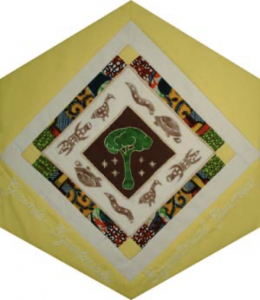Equatorial Guinea

The Block
The interior section of this block, designed by Eva d’Amico, depicts two symbols of Equatorial Guinea’s national coat of arms. Six raffia stars, representing the country’s mainland and five offshore islands, flank an appliquéd silk cotton tree. This tree, which reflects Spanish influence in the area, is believed by some to be the species under which the first treaty was signed between Spain and a local ruler. Also known as the kapok or ceiba tree, its fibre is used for insulation, for padding in sleeping bags and life preservers, as well as for stuffing mattresses and pillows.
An inner border of African wildlife is stamped on the cotton background with fabric ink, while a colourful sampler of West African fabrics creates a patchwork outer frame. Thin bands of raffia, a multi-purpose fibre used for roofing as well for weaving such things as mats and baskets, are top-stitched around the inner square and animal border to complete the piece.
Cultural Profile
Equatorial Guinea, formerly known as Spanish Guinea, is an independent republic in western Africa. It consists of a mainland section called Mbini, the coastal islets of Corisco, Elobey Grande and Elobey Chico, and the islands of Bioko and Annobón. Pygmies are believed to have been the original inhabitants of the area that is now Equatorial Guinea, although only isolated pockets of them remain in the north. The main ethnic group in Mbini, where the majority of the population lives, is the Fang, while the inhabitants of Bioko are primarily Bubi, Nigerians and Fangs. The nation is the only black African state to have Spanish as the official language, although Pidgin English, Fang, Bubi and Igbo are also spoken.
The Fang people have held strongly to their traditions and, as is the case in many societies, music and dance are integral parts of their culture. Dances, including the balélé, are typically performed to music created by bands of three-to-four men playing such instruments as sanzas (small thumb pianos made from bamboo), the mvet, xylophones, great drums and wooden trumpets. The Fang harp, called the ngombi, is another traditional Guinean instrument used during the initiation rite of bwiti and is therefore much revered. The abira, a ceremony that helps cleanse the community of evil, is an important celebration in Equatorial Guinea.
The Fang are noted for their abstract wooden carvings. The art of storytelling has survived through many generations in Equatorial Guinea. As traditions are preserved orally, the role of elders is very important and respecting them is taught to children at an early age. It is one of the strongest cultural traits of Guineans.
The Bubi people, the original inhabitants of Bioko Island, were known as fierce warriors by the Europeans who ventured in the area. Face scarification was a common practice, as the Bubi thought it would spare their children from being taken into slavery by Europeans and, should it happen, that children would be able to identify fellow Bubis if they found themselves away from home.
Equatorial Guineans have been coming to Canada since 1985, often because of civil war, or to make a better life for themselves, however communities of any significant size have yet to be established.
Sponsor: Helen Carroll, in honour of Joy & Martin Carroll
